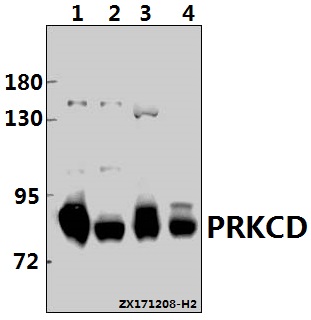Product Name :
PKC δ/PRKCD polyclonal antibody Background :
Activation of protein kinase C (PKC) is one of the earliest events in a cascade that controls a variety of cellular responses, including secretion, gene expression, proliferation, and muscle contraction. PKC isoforms belong to three groups based on calcium dependency and activators. Classical PKCs are calcium-dependent via their C2 domains and are activated by phosphatidylserine (PS), diacylglycerol (DAG), and phorbol esters (TPA, PMA) through their cysteine-rich C1 domains. Both novel and atypical PKCs are calcium-independent, but only novel PKCs are activated by PS, DAG, and phorbol esters. Members of these three PKC groups contain a pseudo-substrate or autoinhibitory domain that binds to substrate-binding sites in the catalytic domain to prevent activation in the absence of cofactors or activators. Control of PKC activity is regulated through three distinct phosphorylation events. Phosphorylation occurs in vivo at Thr500 in the activation loop, at Thr641 through autophosphorylation, and at the carboxy-terminal hydrophobic site Ser660. Atypical PKC isoforms lack hydrophobic region phosphorylation, which correlates with the presence of glutamic acid rather than the serine or threonine residues found in more typical PKC isoforms. The enzyme PDK1 or a close relative is responsible for PKC activation. A recent addition to the PKC superfamily is PKCμ (PKD), which is regulated by DAG and TPA through its C1 domain. PKD is distinguished by the presence of a PH domain and by its unique substrate recognition and Golgi localization. PKC-related kinases (PRK) lack the C1 domain and do not respond to DAG or phorbol esters. Phosphatidylinositol lipids activate PRKs, and small Rho-family GTPases bind to the homology region 1 (HR1) to regulate PRK kinase activity.PKCδ is classified among the calcium-independent, diacylglycerol-activated "novel" members of the PKC superfamily, which includes PKCδ, ε, η, and θ. Unlike other PKC family members, whose activation appears to contribute to tumorigenesis, PKCδ appears to function as a tumor suppresor as down-regulation of this enzyme is associated with tumor progression. Like other conventional and novel PKCs, PKCδ is potently activated by diacylglycerol and phorbol ester and its kinase activity is modulated by phosphorylation within the conserved activation loop (Thr505) as well as the autophosphorylation site (Ser645) and hydrophobic, carboxy-terminal residue (Ser664). Interestingly, PKCδ funtionality is uniquely regulated by phosphorylation at tyrosine residues by receptor tyrosine kinases, members of the Src kinase family, and c-Abl. For more information regarding PKCδ phosphorylation sites, please see PhosphoSitePlus® (www.phosphosite.org). Product :
Rabbit IgG, 1mg/ml in PBS with 0.02% sodium azide, 50% glycerol, pH7.2 Storage&Stability :
Store at 4°C short term. Aliquot and store at -20°C long term. Avoid freeze-thaw cycles. Specificity :
PRKCD pAb detects endogenous levels of PRKCD protein. Immunogen :
Synthetic peptide, corresponding Human PRKCD. Conjugate :
Unconjugated Modification :
Unmodification
PKC δ/PRKCD polyclonal antibody Background :
Activation of protein kinase C (PKC) is one of the earliest events in a cascade that controls a variety of cellular responses, including secretion, gene expression, proliferation, and muscle contraction. PKC isoforms belong to three groups based on calcium dependency and activators. Classical PKCs are calcium-dependent via their C2 domains and are activated by phosphatidylserine (PS), diacylglycerol (DAG), and phorbol esters (TPA, PMA) through their cysteine-rich C1 domains. Both novel and atypical PKCs are calcium-independent, but only novel PKCs are activated by PS, DAG, and phorbol esters. Members of these three PKC groups contain a pseudo-substrate or autoinhibitory domain that binds to substrate-binding sites in the catalytic domain to prevent activation in the absence of cofactors or activators. Control of PKC activity is regulated through three distinct phosphorylation events. Phosphorylation occurs in vivo at Thr500 in the activation loop, at Thr641 through autophosphorylation, and at the carboxy-terminal hydrophobic site Ser660. Atypical PKC isoforms lack hydrophobic region phosphorylation, which correlates with the presence of glutamic acid rather than the serine or threonine residues found in more typical PKC isoforms. The enzyme PDK1 or a close relative is responsible for PKC activation. A recent addition to the PKC superfamily is PKCμ (PKD), which is regulated by DAG and TPA through its C1 domain. PKD is distinguished by the presence of a PH domain and by its unique substrate recognition and Golgi localization. PKC-related kinases (PRK) lack the C1 domain and do not respond to DAG or phorbol esters. Phosphatidylinositol lipids activate PRKs, and small Rho-family GTPases bind to the homology region 1 (HR1) to regulate PRK kinase activity.PKCδ is classified among the calcium-independent, diacylglycerol-activated "novel" members of the PKC superfamily, which includes PKCδ, ε, η, and θ. Unlike other PKC family members, whose activation appears to contribute to tumorigenesis, PKCδ appears to function as a tumor suppresor as down-regulation of this enzyme is associated with tumor progression. Like other conventional and novel PKCs, PKCδ is potently activated by diacylglycerol and phorbol ester and its kinase activity is modulated by phosphorylation within the conserved activation loop (Thr505) as well as the autophosphorylation site (Ser645) and hydrophobic, carboxy-terminal residue (Ser664). Interestingly, PKCδ funtionality is uniquely regulated by phosphorylation at tyrosine residues by receptor tyrosine kinases, members of the Src kinase family, and c-Abl. For more information regarding PKCδ phosphorylation sites, please see PhosphoSitePlus® (www.phosphosite.org). Product :
Rabbit IgG, 1mg/ml in PBS with 0.02% sodium azide, 50% glycerol, pH7.2 Storage&Stability :
Store at 4°C short term. Aliquot and store at -20°C long term. Avoid freeze-thaw cycles. Specificity :
PRKCD pAb detects endogenous levels of PRKCD protein. Immunogen :
Synthetic peptide, corresponding Human PRKCD. Conjugate :
Unconjugated Modification :
Unmodification
-
 Western blot (WB) analysis of PRKCD pAb at 1:1000 dilution Lane1:Hela whole cell lysate(20ug) Lane2:HCT116 whole cell lysate(20ug) Lane3:The Lung tissue lysate of Mouse(40ug) Lane4:The Lung tissue lysate of Rat(40ug)
Western blot (WB) analysis of PRKCD pAb at 1:1000 dilution Lane1:Hela whole cell lysate(20ug) Lane2:HCT116 whole cell lysate(20ug) Lane3:The Lung tissue lysate of Mouse(40ug) Lane4:The Lung tissue lysate of Rat(40ug)
Bioworld Biotech only provide peptides for our antibodies and do not provide additional peptide customization services.
Price/Size :
USD 368/1mg/vial
Tips:
For phospho antibody, we provide phospho peptide(0.5mg) and non-phospho peptide(0.5mg).Describe :
Blocking peptides are peptides that bind specifically to the target antibody and block antibody binding. These peptide usually contains the epitope recognized by the antibody. Antibodies bound to the blocking peptide no longer bind to the epitope on the target protein. This mechanism is useful when non-specific binding is an issue, for example, in Western blotting (WB) and Immunohistochemistry (IHC). By comparing the staining from the blocked antibody versus the antibody alone, one can see which staining is specific; Specific binding will be absent from the western blot or IHC performed with the neutralized antibody.Formula:
Synthetic peptide was lyophilized with 100% acetonitrile and is supplied as a powder. Reconstitute with 0.1 ml DI water for a final concentration of 10 mg/ml.The purity is >90%,tested by HPLC and MS.
Storage:
The freeze-dried powder is more stable. For short time at 2-8°C. For long term storage store at -20°C.
Note :
This product is for research use only (RUO only). Not for use in diagnostic or therapeutic procedures.
 PKC δ/PRKCD polyclonal antibody
PKC δ/PRKCD polyclonal antibody  Datasheet
Datasheet COA
COA MSDS
MSDS SHIP
SHIP